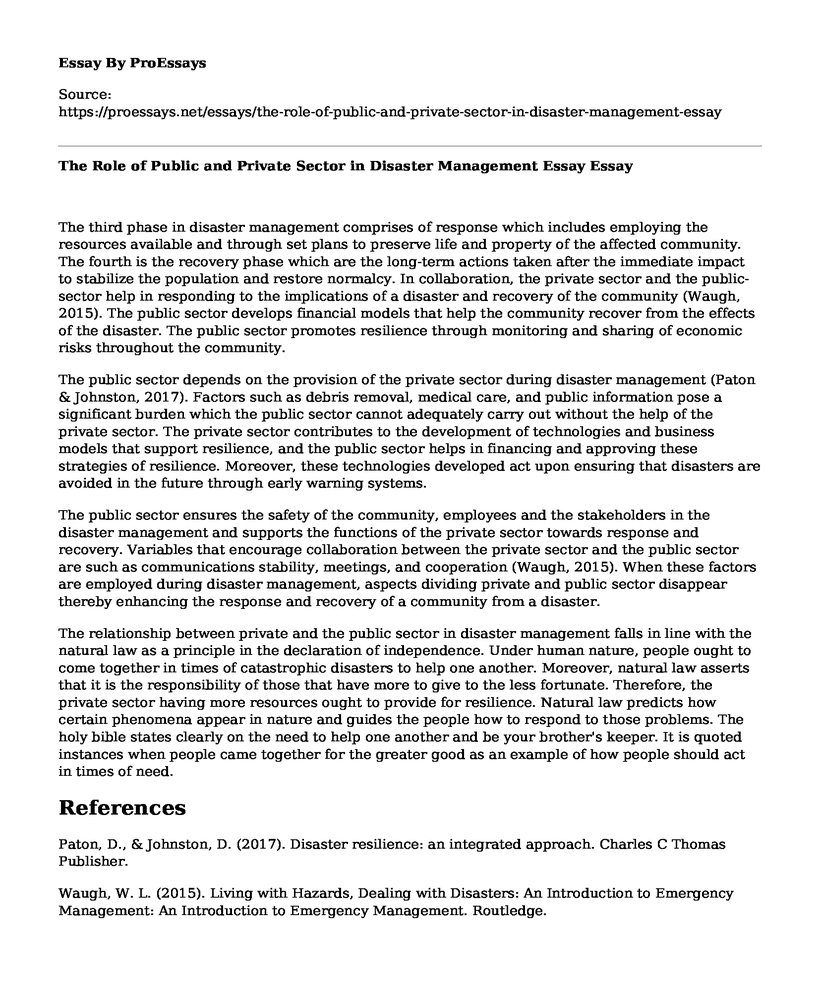The third phase in disaster management comprises of response which includes employing the resources available and through set plans to preserve life and property of the affected community. The fourth is the recovery phase which are the long-term actions taken after the immediate impact to stabilize the population and restore normalcy. In collaboration, the private sector and the public-sector help in responding to the implications of a disaster and recovery of the community (Waugh, 2015). The public sector develops financial models that help the community recover from the effects of the disaster. The public sector promotes resilience through monitoring and sharing of economic risks throughout the community.
The public sector depends on the provision of the private sector during disaster management (Paton & Johnston, 2017). Factors such as debris removal, medical care, and public information pose a significant burden which the public sector cannot adequately carry out without the help of the private sector. The private sector contributes to the development of technologies and business models that support resilience, and the public sector helps in financing and approving these strategies of resilience. Moreover, these technologies developed act upon ensuring that disasters are avoided in the future through early warning systems.
The public sector ensures the safety of the community, employees and the stakeholders in the disaster management and supports the functions of the private sector towards response and recovery. Variables that encourage collaboration between the private sector and the public sector are such as communications stability, meetings, and cooperation (Waugh, 2015). When these factors are employed during disaster management, aspects dividing private and public sector disappear thereby enhancing the response and recovery of a community from a disaster.
The relationship between private and the public sector in disaster management falls in line with the natural law as a principle in the declaration of independence. Under human nature, people ought to come together in times of catastrophic disasters to help one another. Moreover, natural law asserts that it is the responsibility of those that have more to give to the less fortunate. Therefore, the private sector having more resources ought to provide for resilience. Natural law predicts how certain phenomena appear in nature and guides the people how to respond to those problems. The holy bible states clearly on the need to help one another and be your brother's keeper. It is quoted instances when people came together for the greater good as an example of how people should act in times of need.
References
Paton, D., & Johnston, D. (2017). Disaster resilience: an integrated approach. Charles C Thomas Publisher.
Waugh, W. L. (2015). Living with Hazards, Dealing with Disasters: An Introduction to Emergency Management: An Introduction to Emergency Management. Routledge.
Cite this page
The Role of Public and Private Sector in Disaster Management Essay. (2022, Jun 06). Retrieved from https://proessays.net/essays/the-role-of-public-and-private-sector-in-disaster-management-essay
If you are the original author of this essay and no longer wish to have it published on the ProEssays website, please click below to request its removal:
- Management Essay Example: Servant Leadership and Fortuitous Encounters
- Paper Example on Comparison of Operations Management at Amazon Go and Other Supermarkets With 4V
- My Role as a Decision Leader in the Global Market Place Essay
- Essay Sample on Atradius Organizational and Management Philosophy Adaptation
- Paper Example on Maximizing Decision Making With Decision Support Systems
- Essay on Strategic Planning Increases Productivity and Retention at New Belgium Brewing Co
- Conflict Management in Nursing: Strategies for Leaders - Essay Sample







